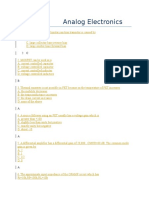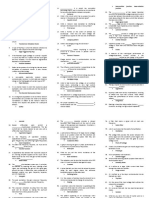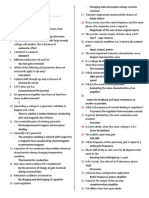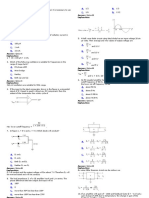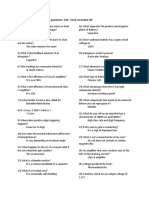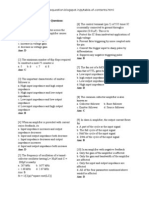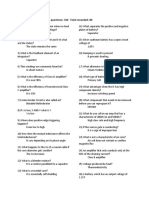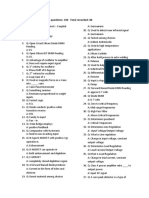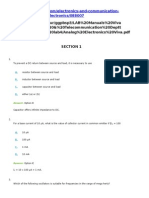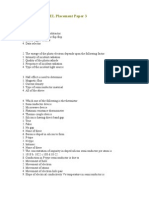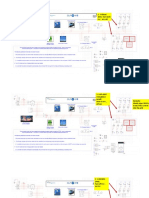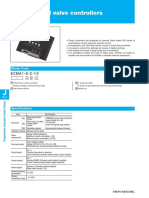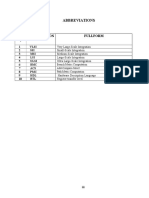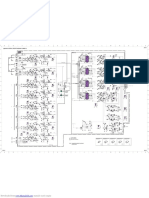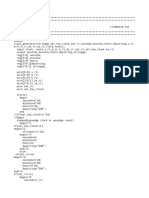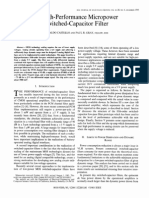1. Which of the following materials has the least forbidden energy gap?
a) Metals
b) Semiconductors
c) Insulators
d) All of the above
Answer: a) Metals
Explanation: Metals have overlapping valence and conduction bands, resulting in no
forbidden energy gap. Semiconductors have a moderate gap (~1 eV), while insulators
have a large gap (>5 eV).
2. In an NPN transistor, the majority carriers in the emitter are:
a) Holes
b) Electrons
c) Both electrons and holes
d) None of the above
Answer: b) Electrons
Explanation: In NPN transistors, the emitter is heavily doped with electrons (negative
charge carriers), making electrons the majority carriers.
3. The barrier potential across each silicon depletion layer is approximately:
a) 0 V
b) 0.3 V
c) 0.7 V
d) 1 V
Answer: c) 0.7 V
Explanation: For silicon diodes, the typical forward voltage drop (barrier potential) is
about 0.7 V.
4. The base of an NPN transistor is:
a) Thick and heavily doped
b) Thin and lightly doped
c) Thick and lightly doped
d) Thin and heavily doped
�Answer: b) Thin and lightly doped
Explanation: A thin and lightly doped base ensures efficient transistor action by
allowing most electrons to pass from emitter to collector.
5. Which of the following is a current-controlled device?
a) MOSFET
b) BJT
c) IGBT
d) JFET
Answer: b) BJT
Explanation: BJTs are current-controlled devices where the output current is
controlled by the input base current.
6. The output of a half-wave rectifier is:
a) AC
b) Pulsating DC
c) Filtered DC
d) Pure DC
Answer: b) Pulsating DC
Explanation: A half-wave rectifier allows only one half of the AC cycle, resulting in a
pulsating DC output.
7. The peak inverse voltage (PIV) of a diode in a half-wave rectifier is equal to:
a) Peak input voltage
b) RMS input voltage
c) Zero
d) Double the peak input voltage
Answer: a) Peak input voltage
Explanation: In a half-wave rectifier, the diode must withstand the peak of the input
AC voltage in the reverse direction.
8. In a full-wave rectifier, the output frequency is:
a) Same as input frequency
b) Half of input frequency
�c) Double the input frequency
d) Zero
Answer: c) Double the input frequency
Explanation: Full-wave rectification inverts every negative half-cycle, resulting in an
output frequency twice that of the input.
9. The ripple factor of a full-wave rectifier is approximately:
a) 0.482
b) 1.21
c) 0.707
d) 1.0
Answer: a) 0.482
Explanation: The ripple factor indicates the amount of AC content in the rectified
output; for a full-wave rectifier, it's approximately 0.482.
10. A Zener diode is primarily used for:
a) Rectification
b) Voltage regulation
c) Amplification
d) Oscillation
Answer: b) Voltage regulation
Explanation: Zener diodes operate in the reverse breakdown region to maintain a
constant voltage across loads.
11. The common base configuration of a transistor has:
a) High input impedance and high output impedance
b) Low input impedance and high output impedance
c) High input impedance and low output impedance
d) Low input and output impedance
Answer: b) Low input impedance and high output impedance
Explanation: The common base configuration offers low input impedance due to the
base-emitter junction and high output impedance at the collector.
12. The current gain (β) in a common-emitter configuration is given by:
�a) IC/IB
b) IC/IE
c) IE/IB
d) IB/IC
Answer: a) IC/IB
Explanation: In CE configuration, β is the ratio of collector current (IC) to base current
(IB).
13. Which transistor configuration provides the highest voltage gain?
a) Common base
b) Common emitter
c) Common collector
d) Emitter follower
Answer: b) Common emitter
Explanation: The common-emitter configuration gives high voltage and power gain
due to its moderate input and output impedance.
14. What is the phase difference between input and output in a common-emitter
amplifier?
a) 0°
b) 90°
c) 180°
d) 360°
Answer: c) 180°
Explanation: The CE amplifier inverts the input signal, resulting in a 180° phase shift.
15. A transistor operates in the active region when:
a) Both junctions are forward biased
b) Both junctions are reverse biased
c) Base-emitter is forward biased and base-collector is reverse biased
d) Base-emitter is reverse biased and base-collector is forward biased
Answer: c) Base-emitter is forward biased and base-collector is reverse biased
�Explanation: This biasing condition ensures proper transistor amplification in the
active region.
16. FETs are preferred over BJTs in ICs because:
a) They are smaller
b) They consume more power
c) They have higher input impedance
d) They are more linear
Answer: c) They have higher input impedance
Explanation: FETs have very high input impedance, making them suitable for ICs and
low-power applications.
17. Which of the following is a unipolar device?
a) BJT
b) JFET
c) SCR
d) UJT
Answer: b) JFET
Explanation: FETs (including JFETs and MOSFETs) operate using only one type of
carrier, hence called unipolar devices.
18. The drain current in a JFET is maximum when:
a) VGS = 0
b) VGS = Vp
c) VDS = 0
d) VGS > 0
Answer: a) VGS = 0
Explanation: The maximum drain current (IDSS) occurs when gate-to-source voltage
(VGS) is zero.
19. Pinch-off voltage in a JFET refers to the value of VDS when:
a) The drain current becomes zero
b) The drain current becomes constant
c) VGS = 0
�d) The channel gets shorted
Answer: b) The drain current becomes constant
Explanation: At pinch-off, the JFET enters saturation, and current becomes
independent of VDS.
20. The output characteristics of a FET resemble:
a) A straight line
b) A parabolic curve
c) A set of flat curves after a knee
d) A sinusoidal curve
Answer: c) A set of flat curves after a knee
Explanation: After pinch-off, the drain current levels off for each constant VGS.
21. The purpose of coupling capacitors in amplifiers is to:
a) Amplify the signal
b) Block DC and pass AC
c) Increase input impedance
d) Reduce distortion
Answer: b) Block DC and pass AC
Explanation: Coupling capacitors block DC components and allow AC signals to pass
between amplifier stages.
22. An emitter follower is also known as:
a) Common base amplifier
b) Common collector amplifier
c) Common emitter amplifier
d) Class A amplifier
Answer: b) Common collector amplifier
Explanation: In an emitter follower, output is taken from the emitter, and it's a CC
configuration.
23. Which class of amplifier has the highest efficiency?
a) Class A
�b) Class B
c) Class AB
d) Class C
Answer: d) Class C
Explanation: Class C amplifiers are the most efficient but produce high distortion,
used mainly for RF applications.
24. A differential amplifier amplifies:
a) Both input signals equally
b) The average of input signals
c) The difference of two input signals
d) None of the above
Answer: c) The difference of two input signals
Explanation: Differential amplifiers amplify the difference between two input voltages.
25. The voltage gain of an amplifier is defined as:
a) Vout / Vin
b) Vin / Vout
c) IC / IB
d) VCE / VBE
Answer: a) Vout / Vin
Explanation: Voltage gain is the ratio of output voltage to input voltage.
26. Which component is essential in an LC oscillator?
a) Resistor
b) Capacitor
c) Inductor
d) Both b and c
Answer: d) Both b and c
Explanation: LC oscillators use an inductor and capacitor in the tank circuit to
generate oscillations.
27. In a crystal oscillator, the crystal acts as a:
�a) Capacitor
b) Inductor
c) Resonator
d) Transistor
Answer: c) Resonator
Explanation: The crystal behaves like a high-Q resonant circuit providing frequency
stability.
28. The Barkhausen criterion for sustained oscillation is:
a) A loop gain of less than 1
b) A phase shift of 180° and gain of 1
c) Total phase shift of 0° or 360° and loop gain = 1
d) Zero phase shift and loop gain = 0
Answer: c) Total phase shift of 0° or 360° and loop gain = 1
Explanation: Barkhausen condition ensures that the feedback is regenerative for
sustained oscillations.
29. Which oscillator is best suited for generating RF signals?
a) Wien Bridge
b) Colpitts
c) RC Phase Shift
d) Crystal
Answer: b) Colpitts
Explanation: Colpitts oscillators are commonly used in RF circuits due to their stable
frequency and ease of tuning.
30. In a phase-shift oscillator, the phase shift provided by the RC network is:
a) 60°
b) 90°
c) 120°
d) 180°
Answer: d) 180°
�Explanation: The RC network provides 180° phase shift, and the amplifier provides
the other 180° to satisfy the Barkhausen criterion.
31. Negative feedback in an amplifier:
a) Increases gain
b) Increases distortion
c) Improves bandwidth and stability
d) Increases input impedance and decreases output impedance only
Answer: c) Improves bandwidth and stability
Explanation: Negative feedback stabilizes gain, reduces distortion, increases
bandwidth, and improves overall amplifier performance.
32. The overall gain of a feedback amplifier is given by:
a) A / (1 - Aβ)
b) A × (1 + Aβ)
c) A / (1 + Aβ)
d) 1 + Aβ
Answer: c) A / (1 + Aβ)
Explanation: For negative feedback, gain is reduced and stabilized using this formula
where A is open-loop gain, and β is feedback factor.
33. Which feedback topology increases both input and output impedance?
a) Voltage series
b) Voltage shunt
c) Current series
d) Current shunt
Answer: c) Current series
Explanation: Current series feedback increases both input and output impedance.
34. Which parameter is least affected by negative feedback?
a) Bandwidth
b) Gain
c) Stability
�d) Noise
Answer: d) Noise
Explanation: While negative feedback improves gain stability and bandwidth, it does
not significantly reduce noise introduced from external sources.
35. The primary purpose of using feedback in amplifiers is to:
a) Increase distortion
b) Reduce gain
c) Stabilize gain and improve performance
d) Increase output impedance
Answer: c) Stabilize gain and improve performance
Explanation: Negative feedback helps maintain consistent gain across environmental
and component variations.
36. A class B amplifier conducts for:
a) 360°
b) 180°
c) 90°
d) Less than 90°
Answer: b) 180°
Explanation: In Class B, each transistor conducts for only half the input signal cycle.
37. Crossover distortion occurs in which amplifier class?
a) Class A
b) Class B
c) Class C
d) Class AB
Answer: b) Class B
Explanation: Crossover distortion is seen at the zero crossing point where both
transistors in a Class B push-pull amplifier are off.
38. Class AB amplifier is designed to overcome:
a) Power loss
�b) Bandwidth limitation
c) Crossover distortion
d) High input impedance
Answer: c) Crossover distortion
Explanation: Class AB slightly biases both transistors to conduct a bit more than 180°,
reducing crossover distortion.
39. Class A amplifier is least efficient because:
a) It has high distortion
b) It conducts for less than 180°
c) The transistor is always on, dissipating power
d) Uses negative feedback
Answer: c) The transistor is always on, dissipating power
Explanation: In Class A, the transistor conducts all the time, leading to significant
power loss.
40. The efficiency of a Class B amplifier is approximately:
a) 25%
b) 50%
c) 78.5%
d) 90%
Answer: c) 78.5%
Explanation: Theoretical maximum efficiency for Class B is 78.5%, much higher than
Class A (25-30%).
41. The purpose of a filter in a rectifier circuit is to:
a) Amplify the signal
b) Remove the AC component
c) Boost the voltage
d) Invert the waveform
Answer: b) Remove the AC component
Explanation: Filters smooth out the pulsating DC by removing the ripple (AC content).
�42. Which filter is most effective for reducing ripple in power supplies?
a) RC filter
b) LC filter
c) L filter
d) π-filter
Answer: d) π-filter
Explanation: π-filters (capacitor-inductor-capacitor) are very effective in smoothing
ripples.
43. The main advantage of using a voltage regulator is:
a) Higher power output
b) Fixed DC output regardless of input variations
c) Rectification
d) Low power consumption
Answer: b) Fixed DC output regardless of input variations
Explanation: Regulators maintain a constant DC output despite load or supply
changes.
44. A linear voltage regulator dissipates power as:
a) Heat
b) Light
c) Sound
d) None of these
Answer: a) Heat
Explanation: Linear regulators control output by dropping excess voltage across a
pass transistor, releasing energy as heat.
45. Which device is most suitable for providing a fixed reference voltage?
a) LED
b) Zener diode
c) BJT
d) MOSFET
�Answer: b) Zener diode
Explanation: Zener diodes in reverse breakdown provide a stable reference voltage
for regulation.
46. A photodiode operates in:
a) Forward bias
b) Reverse bias
c) Zero bias
d) Either bias
Answer: b) Reverse bias
Explanation: Photodiodes are reverse biased to detect light by measuring the
photocurrent.
47. LEDs emit light when:
a) Forward biased
b) Reverse biased
c) Unbiased
d) Pulsed
Answer: a) Forward biased
Explanation: LEDs emit light when forward biased, causing electron-hole
recombination.
48. Varactor diodes are used primarily for:
a) Light emission
b) Voltage regulation
c) Tuning circuits
d) Rectification
Answer: c) Tuning circuits
Explanation: Varactors act as voltage-controlled capacitors, useful in RF tuning
applications.
49. Tunnel diode is used for:
a) Power rectification
b) Voltage clamping
�c) High-frequency oscillations
d) Amplification
Answer: c) High-frequency oscillations
Explanation: Tunnel diodes exhibit negative resistance, useful for oscillators at
microwave frequencies.
50. Which device shows negative resistance in its characteristics?
a) Zener diode
b) Tunnel diode
c) Photodiode
d) LED
Answer: b) Tunnel diode
Explanation: Tunnel diode’s V-I curve has a region where current decreases as
voltage increases, showing negative resistance.
51. In a half-wave rectifier, the ripple factor is approximately:
a) 0.48
b) 0.707
c) 1.21
d) 1.5
Answer: c) 1.21
Explanation: The ripple factor is the ratio of AC content to DC content in the output.
For a half-wave rectifier, it's 1.21.
52. In a full-wave rectifier, the frequency of output ripple is:
a) Same as input
b) Half the input
c) Twice the input
d) Zero
Answer: c) Twice the input
Explanation: Full-wave rectification inverts both halves of the AC waveform, doubling
the frequency of the ripple.
53. Which of the following rectifier circuits uses a center-tapped transformer?
�a) Half-wave
b) Full-wave
c) Bridge
d) None
Answer: b) Full-wave
Explanation: A center-tapped full-wave rectifier uses two diodes and a center-tapped
transformer to produce full-wave output.
54. What is the purpose of the bleeder resistor in a power supply?
a) To reduce power
b) To discharge filter capacitors
c) To rectify the signal
d) To increase gain
Answer: b) To discharge filter capacitors
Explanation: Bleeder resistors slowly discharge capacitors when power is turned off
to prevent electric shock or damage.
55. A capacitor input filter in a rectifier is also called:
a) π-filter
b) Shunt capacitor filter
c) Inductor filter
d) RC filter
Answer: b) Shunt capacitor filter
Explanation: It is placed immediately after the rectifier output and before any
inductors to filter the ripple.
56. In the small-signal model of a BJT, ‘rπ’ represents:
a) Output resistance
b) Input resistance at the base
c) Feedback resistance
d) Resistance between collector and emitter
Answer: b) Input resistance at the base
�Explanation: ‘rπ’ is the resistance seen at the base in the hybrid-π model.
57. The transconductance (gm) of a BJT is given by:
a) β/rπ
b) IC/VBE
c) IC/VT
d) IE/VBE
Answer: c) IC/VT
Explanation: gm = IC / VT, where VT is the thermal voltage (approximately 26 mV at
room temperature).
58. Which of the following is true for small-signal analysis?
a) Nonlinear behavior is considered
b) Signal magnitude is comparable to bias voltage
c) Signal is superimposed on bias and linearized
d) Only AC analysis is performed
Answer: c) Signal is superimposed on bias and linearized
Explanation: Small-signal analysis linearizes the non-linear device characteristics
around an operating point.
59. The small signal voltage gain of a common-emitter amplifier with resistance Rc is
approximately:
a) β × Rc
b) -gm × Rc
c) Rc / rπ
d) 1 / gmRc
Answer: b) -gm × Rc.
Explanation: The small signal gain Av ≈ -gm × Rc (negative sign due to phase
inversion).
60. The small-signal hybrid-π model is applicable to:
a) Large-signal analysis
b) Non-linear region
c) AC analysis near Q-point
�d) Noise analysis only
Answer: c) AC analysis near Q-point
Explanation: The hybrid-π model is a linear small-signal model for analyzing BJT
behavior near its operating point.
61. The ideal input impedance of an op-amp is:
a) Zero
b) 10kΩ
c) 100kΩ
d) Infinite
Answer: d) Infinite
Explanation: An ideal op-amp draws no input current, implying infinite input
impedance.
62. The ideal output impedance of an op-amp is:
a) Zero
b) Infinite
c) 100Ω
d) 1kΩ
Answer: a) Zero
Explanation: Ideal op-amps can drive any load, requiring zero output impedance.
63. For an ideal op-amp, the voltage difference between the input terminals is:
a) Zero
b) Equal to Vout
c) Infinite
d) Equal to the input bias voltage
Answer: a) Zero
Explanation: With negative feedback, the op-amp maintains both inputs at the same
voltage (virtual short).
64. The gain of a non-inverting op-amp configuration is given by:
a) -Rf/R1
�b) 1 + Rf/R1
c) Rf/R1
d) 1 / (Rf + R1)
Answer: b) 1 + Rf/R1
Explanation: Non-inverting gain formula includes unity plus feedback ratio.
65. In an inverting amplifier, the phase shift between input and output is:
a) 0°
b) 90°
c) 180°
d) 360°
Answer: c) 180°
Explanation: Inverting op-amp produces an output 180° out of phase with input.
66. The slew rate of an op-amp is defined as:
a) Maximum voltage gain
b) Change in output voltage per unit time
c) Input impedance
d) Power gain
Answer: b) Change in output voltage per unit time
Explanation: Slew rate limits how fast the output can change, expressed in V/µs.
67. An op-amp integrator circuit produces output:
a) Proportional to input
b) Proportional to the integral of input
c) Proportional to the derivative of input
d) Independent of input
Answer: b) Proportional to the integral of input
Explanation: The capacitor in feedback causes the output to integrate the input
voltage over time.
68. In a differential amplifier using op-amps, the output is:
a) Vin1 + Vin2
�b) Vin1 - Vin2
c) Vin1 × Vin2
d) Vin1 / Vin2
Answer: b) Vin1 - Vin2
Explanation: A differential amplifier subtracts the two input signals.
69. Which configuration provides unity gain in op-amps?
a) Inverting amplifier
b) Non-inverting amplifier with Rf = 0
c) Buffer (voltage follower)
d) Integrator
Answer: c) Buffer (voltage follower)
Explanation: A voltage follower has unity gain and high input impedance, often used
for isolation.
70. The common-mode rejection ratio (CMRR) in op-amps should be:
a) Low
b) Zero
c) High
d) Depends on application
Answer: c) High
Explanation: High CMRR ensures the op-amp rejects common-mode signals (noise)
and amplifies the differential input only.
71. An oscillator differs from an amplifier because it:
a) Requires no input signal
b) Has a higher gain
c) Needs no feedback
d) Works without power supply
Answer: a) Requires no input signal
Explanation: Oscillators generate their own signal through positive feedback and do
not need an external input.
�72. The condition for sustained oscillations in a feedback oscillator is known as:
a) Miller’s rule
b) Shannon’s law
c) Barkhausen criterion
d) Ohm’s law
Answer: c) Barkhausen criterion
Explanation: It states that loop gain (Aβ) must be equal to 1 and the phase shift
around the loop must be 0° or 360°.
73. Which of the following is a sinusoidal oscillator?
a) Astable multivibrator
b) RC phase shift oscillator
c) Schmitt trigger
d) Monostable multivibrator
Answer: b) RC phase shift oscillator
Explanation: It generates a sine wave output by producing 180° phase shift through
RC sections and 180° from the amplifier.
74. In a Wien bridge oscillator, the frequency of oscillation depends on:
a) Inductance and resistance
b) Resistance and capacitance
c) Voltage and current
d) Temperature
Answer: b) Resistance and capacitance
Explanation: The Wien bridge oscillator uses an RC network to set the oscillation
frequency.
75. The frequency of an LC oscillator is determined by:
a) Power supply
b) Feedback gain
c) Inductance and capacitance values
d) Load resistance
�Answer: c) Inductance and capacitance values
Explanation: The resonance condition of an LC tank circuit defines the oscillation
frequency.
76. Which oscillator is best suited for generating high-frequency signals?
a) RC phase shift
b) Wien bridge
c) Colpitts
d) Integrator
Answer: c) Colpitts
Explanation: LC oscillators like Colpitts are preferred for high-frequency sinusoidal
wave generation.
77. In Colpitts oscillator, feedback is obtained via:
a) Transformer coupling
b) Tapped inductor
c) Capacitive divider
d) Resistor divider
Answer: c) Capacitive divider
Explanation: Colpitts oscillator uses a capacitive divider to feed back a portion of the
output signal.
78. In Hartley oscillator, feedback is provided through:
a) Capacitors
b) Inductor tap
c) Diodes
d) Resistors
Answer: b) Inductor tap
Explanation: Hartley oscillator uses a tapped inductor for feedback.
79. Which oscillator does not use an LC network?
a) Colpitts
b) Hartley
�c) RC Phase Shift
d) Clapp
Answer: c) RC Phase Shift
Explanation: RC phase shift oscillators rely only on resistor-capacitor networks.
80. Crystal oscillators are highly stable due to:
a) Magnetic properties
b) Low resistance
c) Piezoelectric property of crystal
d) High gain
Answer: c) Piezoelectric property of crystal
Explanation: Crystals maintain constant frequency due to stable mechanical
resonance.
81. A Schmitt trigger is used for:
a) Sine wave amplification
b) Generating square waves
c) Frequency modulation
d) Integrating signals
Answer: b) Generating square waves
Explanation: Schmitt triggers convert analog signals into clean digital pulses with
hysteresis.
82. A multivibrator that does not require any triggering signal is:
a) Monostable
b) Bistable
c) Astable
d) Schmitt trigger
Answer: c) Astable
Explanation: An astable multivibrator oscillates continuously without an external
trigger.
83. Which of the following circuits can be used as a flip-flop?
�a) Astable multivibrator
b) Bistable multivibrator
c) Monostable multivibrator
d) RC phase shift oscillator
Answer: b) Bistable multivibrator
Explanation: A bistable multivibrator has two stable states and acts as a flip-flop.
84. Which circuit can be used to generate time delays?
a) Schmitt trigger
b) Monostable multivibrator
c) Astable multivibrator
d) Bistable multivibrator
Answer: b) Monostable multivibrator
Explanation: Monostable circuits generate a single pulse of predetermined duration
on each trigger.
85. Integrator circuits are used to:
a) Differentiate input
b) Convert square waves into triangular waves
c) Generate noise
d) Regulate voltage
Answer: b) Convert square waves into triangular waves
Explanation: Integrators produce a ramp (triangle) waveform from a constant-level
(square) input.
86. A differentiator circuit outputs:
a) The integral of the input
b) A waveform with decreasing frequency
c) A spike or short pulse corresponding to changes in input
d) The average of input waveform
Answer: c) A spike or short pulse corresponding to changes in input
�Explanation: Differentiators produce sharp pulses on changes (edges) of the input
signal.
87. Which op-amp configuration introduces a 90° phase lead to the input signal?
a) Inverting amplifier
b) Integrator
c) Differentiator
d) Voltage follower
Answer: c) Differentiator
Explanation: Differentiators lead the phase of the input signal by 90°.
88. Which waveform is generated by an op-amp integrator for a square wave input?
a) Sine wave
b) Triangular wave
c) Square wave
d) DC voltage
Answer: b) Triangular wave
Explanation: Integration of a constant (square wave) yields a ramp (triangular)
waveform.
89. The function of a zero-crossing detector is to:
a) Detect maximum voltage
b) Detect signal distortion
c) Detect when signal changes polarity
d) Limit voltage
Answer: c) Detect when signal changes polarity
Explanation: A zero-crossing detector uses op-amp to output a high or low signal as
input crosses zero.
90. What will be the output of a comparator when the input exceeds the reference
voltage?
a) Zero
b) Saturation (positive or negative)
c) Sinusoidal
�d) Constant DC
Answer: b) Saturation (positive or negative)
Explanation: Comparators output a high or low voltage depending on whether the
input is above or below the reference.
91. A Zener diode is used for:
a) Rectification
b) Amplification
c) Voltage regulation
d) Oscillation
Answer: c) Voltage regulation
Explanation: Zener diodes maintain a constant voltage across loads by operating in
reverse breakdown.
92. The key feature of a photodiode is that it:
a) Emits light
b) Regulates voltage
c) Generates current when exposed to light
d) Amplifies the signal
Answer: c) Generates current when exposed to light
Explanation: Photodiodes convert light into electrical current, used in sensors.
93. The device used for triggering in SCRs is:
a) Collector
b) Anode
c) Gate
d) Cathode
Answer: c) Gate
Explanation: SCRs are turned on by a pulse at the gate terminal while forward-
biased.
94. The TRIAC is a device that conducts:
a) In one direction only
�b) In both directions when triggered
c) Without triggering
d) Only at high voltages
Answer: b) In both directions when triggered
Explanation: TRIACs are bidirectional devices used in AC power control.
95. A DIAC is used primarily for:
a) Amplification
b) Rectification
c) Triggering TRIACs
d) Filtering
Answer: c) Triggering TRIACs
Explanation: DIACs are bidirectional devices that help in precise triggering of TRIACs.
96. Which of the following devices is a unidirectional device?
a) DIAC
b) TRIAC
c) SCR
d) UJT
Answer: c) SCR
Explanation: SCR (Silicon Controlled Rectifier) conducts in one direction only.
97. The unijunction transistor (UJT) is primarily used as a:
a) Switch
b) Amplifier
c) Oscillator
d) Rectifier
Answer: c) Oscillator
Explanation: UJTs are commonly used in relaxation oscillator circuits.
98. The characteristic of a tunnel diode is:
a) High forward voltage
�b) Negative resistance region
c) High breakdown voltage
d) Light emission
Answer: b) Negative resistance region
Explanation: Tunnel diodes exhibit a region where current decreases with increasing
voltage.
99. An LED emits light when:
a) Forward biased
b) Reverse biased
c) Exposed to sunlight
d) High voltage applied
Answer: a) Forward biased
Explanation: LEDs emit light due to electron-hole recombination when forward biased.
100. The breakdown in a Zener diode is due to:
a) Avalanche and Zener effects
b) Thermal heating
c) Diffusion
d) Magnetic field
Answer: a) Avalanche and Zener effects
Explanation: At low voltages, Zener effect dominates; at higher voltages, avalanche
breakdown occurs.











